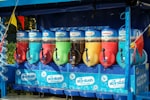The run up to the 2018 NHL Trade Deadline is here, so let’s refresh our memories on how this all works.
When
The trade deadline this year is Monday, February 26. As always, the exact deadline is 3 p.m. New York time. To be eligible for the playoffs, a player must be under contract to the NHL team he will be playing for by that time. You can trade anyone you like after the deadline, but they aren’t eligible for the playoffs on their new team, so it rarely happens.
We may hear of trades later than three o’clock though, maybe even much later, as deals have to be approved and registered with the league.
The Leafs are on the road that day, going to Florida to play first the Lightning on the 26th and the Panthers the next day. This will make their roster moves more complicated, or perhaps just their decisions about who to put on the plane.
The Marlies are sitting at home between games on the previous Saturday and the following Wednesday, which is an ideal deadline day schedule.
What Changes
The thing of most value to the Leafs this year is the end of the 23-man roster limit they’ve been chafing against for weeks.
16.4 Active Roster Size; Playing Roster.
(a) There shall be a maximum of twenty-three (23) Players on each Club’s Active Roster at any one time, provided, however, that, on the date of each season’s Trade Deadline, a Club’s Active Roster may be increased to any number of Players the Club, in its discretion, so determines, subject to Article 50.
So when the Leafs get on the plane to Tampa, be that on deadline day or the day before, they can do it knowing they can have as many players on the active roster as will fit under the cap. Or in the Leafs’ case, inside the LTIR room.
With 25 players on the roster at time of writing, three on IR, the Leafs have just under 3.8 million of LTIR space to hold salaries and bonuses for any players added to the roster, so there is space to add some extra bodies.
What Doesn’t Change
Waiver rules. All players who must clear waivers to be loaned to the AHL, still need to clear in the final weeks of the season. There are restrictions on who can be sent to the AHL after the deadline, however.
Deadline Day and the AHL
Someone will use the term “clear day” and get us all confused about how the trade deadline affects the AHL. People still say Swedish Elite League and Phoenix Coyotes too. But there is no clear day any longer; however, there are specific deadline rules for the AHL.
Deadline day affects AHL playoff eligibility, not just NHL playoffs. An NHL-contracted player must be on the roster of the AHL team at the deadline to qualify for the AHL playoffs. This rule does not affect players added to the AHL team via ATO, PTO or AHL contracts or players recalled from loan to other leagues. So Carl Grundström can come over and play for the Marlies whenever his season is over in Sweden.
What happens with players already on the AHL or NHL roster is often a set of paper transactions. Let’s use Kasperi Kapanen as the example. Assume he is on the NHL roster, going about his business being awesome. On deadline day he may be “papered down” to the AHL at 3 p.m. which gives him eligibility to play in the AHL playoffs once the Leafs are eliminated.
He can be recalled to the Leafs immediately, or at any time after, under the recall rules.
There are three ways to recall a player to the NHL team who has been loaned to the AHL.
- Once the AHL season is over, any NHL-contracted player can be added to the NHL roster
- There are four regular recall slots available to be used at any time
- There is an unlimited number of emergency recalls to be used to replace injured players/
There are also rules for loaning players to the AHL once the deadline has passed. A team may do it, but only if the player in question is “on recall” post-deadline under the conditions listed above or is being sent on a conditioning stint.
There is one exception to that rule. If a player had been recalled to the NHL from the AHL prior to the deadline, but was injured at the deadline and therefore couldn’t be sent down (remember only healthy players are supposed to be sent to the AHL), that player can be loaned back down when ready to play.
So let’s take another example. Frederik Gauthier is on the AHL roster on deadline day, going about his business, uh, playing centre, and the Leafs want him available for the NHL playoffs and the AHL playoffs. If they call him up before 3 p.m., he’s not going to be eligible for the AHL playoffs. So they have to wait and do it after using the recall rules listed above.
With the Leafs in a position where both they and the Marlies are making the playoffs, there’s no way they can just wait out the AHL season to call up whoever they might want, so they have decisions to make about who they want eligible to play in the AHL, given that it’s a very real possibility the AHL playoffs last longer this season. Again, any players called up have to fit in the available LTIR space, so the Leafs can’t be too ambitious about adding players. They also can’t just waive Roman Polak whenever they want post-deadline to clear cap space.
When the regular season is over, and there is no salary cap, that’s when things get more interesting for playoff teams. At that point, the roster can hold as many bodies as their are press-box chairs for them to sit in.



